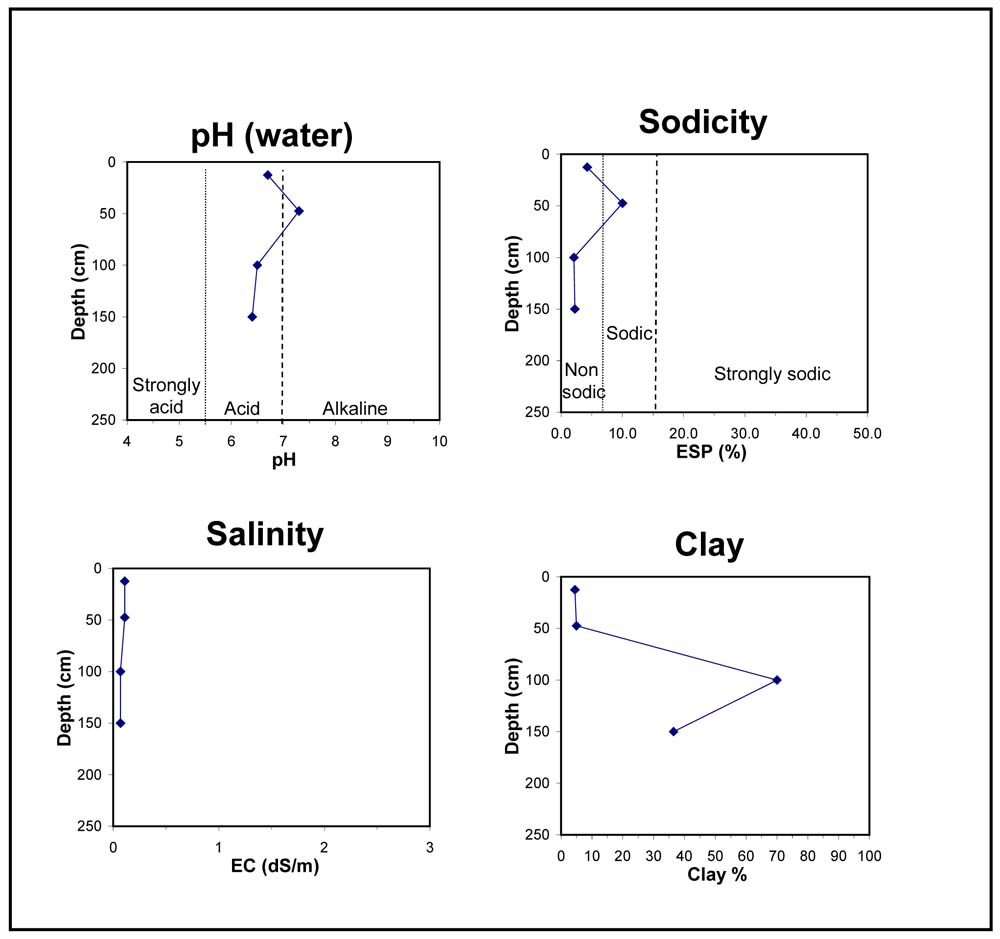GL43
Location: Drik Drik
Australian Soil Classification: Haplic, Eutrophic, Red FERROSOL (confidence level 1)
General Landscape Description: Dune
Site Description: Lower slope, <3%
Land Unit: Nelson Plains and Dunes
Geology: Quaternary aeolian
General Land Unit Description: This land unit occurs in the south western corner of the region. The land unit is generally composed of siliceous sand dunes and plains over calcareous material. The partly consolidated calcareous deposits were formed in an arcuate band (north west / south east trending) formed by the retreat of the Murray Sea. The siliceous dune and sand sheet material is generally of aeolian origin. Although there is a large area of this land unit in the south west of the study area there are also some isolated patches, mainly mixed amongst the Follet land unit that could not be mapped due to restrictions of scale.
The sand varies from orange (GL48), to red (GL39) to a paler colour. The orange and red sands are usually associated with the calcareous material, whereas the paler sands tend to have less carbonate (e.g. GL51, GL38) or the calcareous material is greater than 2 metres deep (e.g. GL50). Another soil variant occurs on the swales in between the dunes. This soil tends to have a heavier textured subsoil which may or may not have calcareous material underneath.
This site is characterised by a strong texture contrast (Chromosol) but it also has a high level of free iron in the subsoil, which is it’s most distinguishing feature. This soil typically occurs on the lower dunes and slopes of some of the dunes. This soil tends to have a heavier textured subsoil compared to the Tenosols and Rudosol, and may or may not have limestone underneath. This soil type has been mapped as the Follet Dunes and Rises land unit, possibly due to the deep sandy topsoil, although due to the limestone at depth, it sits better in the Nelson Dunes and Plains land unit. It is not clear what the origin of the subsoil is, although it is likely that it may be of basalt origin, since high free iron is often associated with this geology. This soil type is similar to site GL42, GL43 and GL80 and they tend to have a higher capability of supporting a range of land uses (e.g. Viticulture), due to their favourable physical and chemical properties.
Soil Profile Morphology
| A1 | 0-30 cm | Very dark brown (10YR2/2); sandy loam; weak to massive structure; weak consistence, dry; pH 7.4; changes to:
|
| A3 | 30-50 cm | Reddish brown (5YR4/3); sandy clay loam; massive structure; firm consistence, dry; pH 7.4; changes to:
|
| Subsoil |
| |
| B21 | 50-140 cm | Reddish brown (2.5YR4/4); sandy clay loam; massive structure; very firm consistence, moist; pH 7.4; changes to:
|
| B22 | 140+ cm | Reddish brown (2.5YR4/4); light medium clay; weak to medium structure; strong consistence, dry; pH 7.1. |
Key profile features:
- High in free iron
Soil Profile Characteristics:
- | pH | Salinity | ||
Surface Soil (A1 horizon) | Slightly Alkaline | Low | Non-Sodic | None |
Subsoil (50-140 cm) | Slightly Alkaline | Very Low | Non-Sodic | None |
Deeper Subsoil (140+ cm) | Slightly Alkaline | Very Low | Non-Sodic | None |

Chemical and Physical Analysis:
Horizon | Horizon Depth (cm) | pH (water) | pH (CaCl2) | EC dS/m | Organic Carbon % | Total Nitrogen % | Exchangeable Cations | Coarse Sand (0.2-2.0 mm) % | Fine Sand (0.02-0.2 mm) % | Silt (0.002-0.02 mm) % | Clay (<0.002 mm) % | Field Capacity % w/w | Wilting Point % w/w | |||
Ca | Mg | K | Na | |||||||||||||
meq/100g | ||||||||||||||||
A1 | 0-30 | 7.4 | 7.0 | 0.09 | 1.9 | 0.09 | 9.3 | 0.56 | 0.38 | 0.07 | 25 | 52 | 4 | 17 | 12.7 | 7.0 |
A3 | 30-50 | 7.4 | 6.8 | <0.05 | 7.1 | 1.4 | 0.21 | 0.06 | 21 | 48 | 3 | 27 | 14.4 | 8.9 | ||
B21 | 50-100 | 7.4 | 6.8 | <0.05 | 6.1 | 2.7 | 0.21 | 0.09 | 17 | 39 | 2 | 42 | 22.2 | 14.2 | ||
100-140 | 7.4 | 6.9 | 0.05 | 6.5 | 3.1 | 0.27 | 0.1 | 14 | 33 | 2 | 52 | 27.1 | 17.9 | |||
B22 | 140+ | 7.1 | 6.6 | 0.08 | 11 | 3.5 | 0.19 | 0.31 | 6 | 15 | 2 | 77 | 39.6 | 27.7 | ||
Profile Described By: Natalie Baxter and Grant Boyle, 3rd October 2000.


